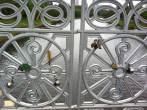MORELL BRIDGE
OVER YARRA RIVER, ANDERSON STREET SOUTH YARRA, MELBOURNE CITY
-
Add to tour
You must log in to do that.
-
Share
-
Shortlist place
You must log in to do that.
- Download report
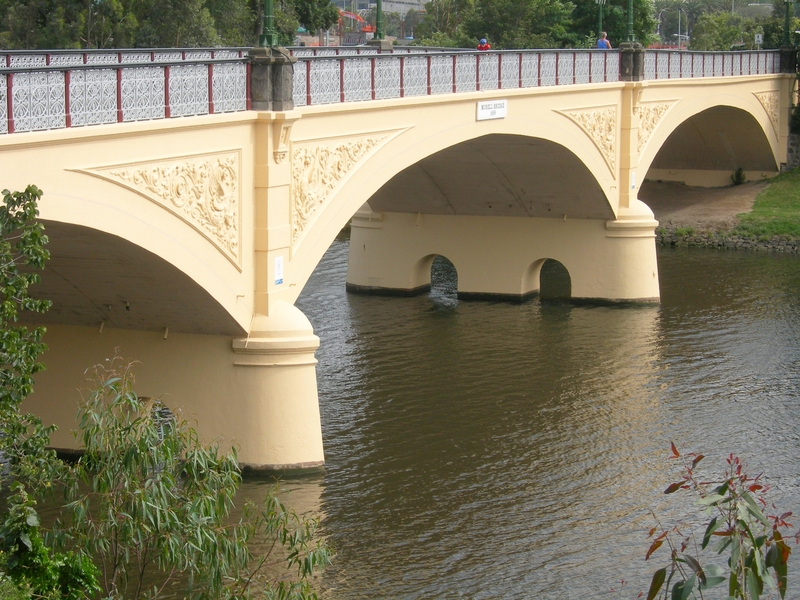


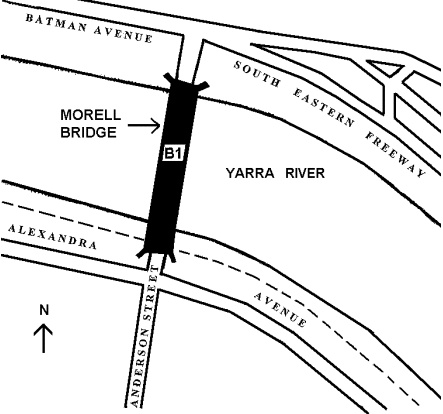
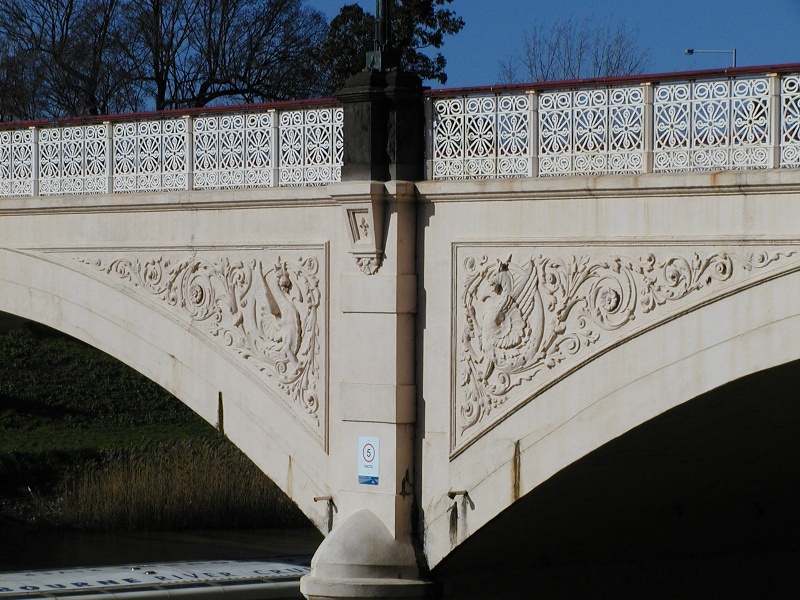

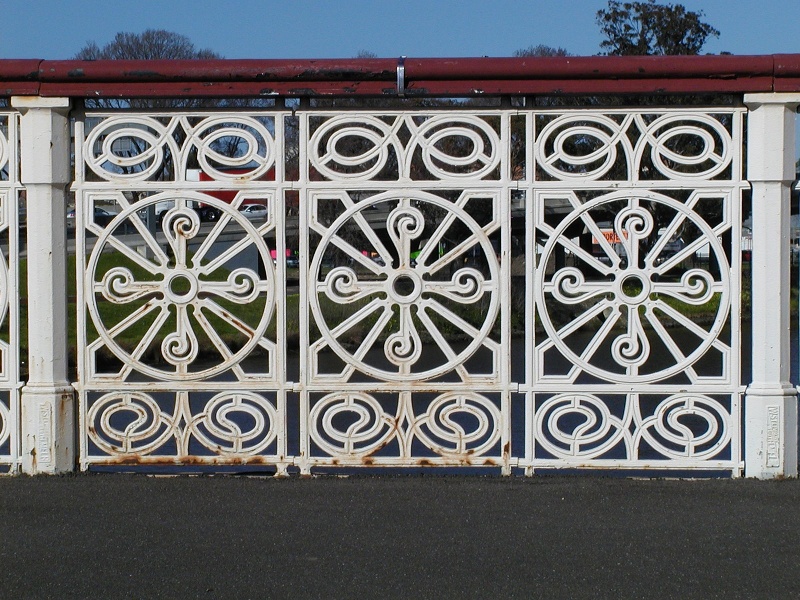
Statement of Significance
What is significant?
Morell Bridge over the Yarra River at Anderson Street, South Yarra was constructed in 1899 by the firm of Monash and Anderson using the Monier concrete construction technique. The Monier system of construction was patented in 1867 by Joseph Monier, a French manufacturer of garden ware. He used a grid of small-diameter iron bars embedded in a coarse mortar especially for the construction of planter pots. The technique and patents were gradually extended to cover, amongst other things, arch bridges. Monash and Anderson operated as the Victorian agency of the Sydney based engineering and contracting firm of Carter Gummow & Co, who held the Australian patent for the Monier technique. JTN Anderson from Monash and Anderson supervised the construction of the bridge with the design attributed to WG Baltzer, from Carter Gummow & Co. The bridge was erected on dry land and upon completion the Yarra River was diverted under it. In May 1936 the bridge was named after Sir Stephen Morell, Lord Mayor of Melbourne between 1926 and 1928, as a tribute to his municipal service and enthusiasm for rowing. The bridge, which carries Anderson Street over the Yarra River, was designed as a Monier arch structure which used a grid of iron bars embedded in concrete as reinforcement. The reinforced concrete arches are filled with earth. The 102-metre length bridge is divided into three equal spans, with concrete abutments and piers. The concrete surfaces are finished with cement mortar and painted grey and the ornamental balustrade and handrails are of cast iron. The spandrel panels are ornamented with stucco in a stylised foliation and dragon design. Each pier is mounted by a light standard containing twin lamps. The road over the bridge consists of two concrete footpaths and a carriageway.
How is it significant?
Morell Bridge over the Yarra River is of architectural, aesthetic and historical significance to the state of Victoria.
Why is it significant?
Morell Bridge over the Yarra River is of architectural and aesthetic importance as the first reinforced concrete bridge built in Victoria and the first in Victoria to use the innovative Monier construction technique. The bridge was revolutionary in its design being built only two years after the first reinforced concrete bridge in the world was constructed. The bridge is important for its associations with the engineering firm of Monash and Anderson who went on to design and construct many more important Victorian bridges. The construction of the bridge on dry land and the diversion of the Yarra River beneath it are very unusual and contribute to both the architectural and historical significance of the Morell Bridge.
Morell Bridge is of aesthetic importance as an attractive landmark bridge on the Yarra River with its distinctive arches, double lamps and cast iron balustrade.
The Morell Bridge over the Yarra River is of historical importance for its associations with Sir Stephen Morell, who was a prominent Victorian businessman and Lord Mayor between 1926 and 1928. The bridge was named the Morell Bridge in 1936 in recognition of Morell's contribution to Melbourne.
-
-
MORELL BRIDGE - History
Contextual History:
In Melbourne punts were operating across the Yarra River at the city and Richmond in the late 1830s. In 1845 the Melbourne Bridge Co. was licensed to build an iron toll bridge below the present site of Princes Bridge, but could only raise enough capital to erect a wooden bridge. The company charge pedestrians crossing the river 1d each; cattle and horses 2d a head; horse and bullock drays 6d; and private carriages 1s each. The significance of such early developments was that they established main arterial routes for all time, regardless of future needs or sound engineering principles. By the time increasing traffic forced government authorities to intervene and build public bridges, the shape of cities and near suburbs had been determined by thousands of private decisions and accidents of fate .
History of Place:
The Morell Bridge over the River Yarra at Anderson Street, South Yarra, built in 1899 was constructed by the engineering firm of Monash and Anderson using the Monier concrete construction technique. The partnership operated as the Victorian Agency of the Sydney based engineering and contracting firm of C. Gummow and Co. who held the patent for the Monier Concrete Construction technique. Carter and Gummow were responsible for the earlier Annandale sewer aqueducts in Sydney which used the Monier construction technique. In securing the Victorian Agency of the Monier Construction technique from Carter Gummow and Co., JTN Anderson?s actions clearly shaped the direction of the Monash and Anderson partnership and its prominent association with concrete bridge construction in Victoria.
Anderson supervised the construction of the bridge with the design attributed to W.G.Baltzer, from Carter Gummow and Co. This bridge was the first reinforced concrete bridge built in Victoria. The bridge was erected on dry land and upon completion the Yarra River was diverted under it. The total cost of 6000 pounds was shared by the Melbourne City Council and the Victorian State Government.
Morell Bridge was named after Sir Stephen Joseph Morell (1869-1944) businessman and Lord Mayor. In 1925 Morell was made an alderman and in 1926 succeeded Sir William Brunton as lord mayor. He was unanimously elected to a second term and in, 1928 declined a third. Bridges over the Yarra were an issue of his mayoral years, as was the work of the Metropolitan Town Planning Commission, but initiatives were frustrated by the division of metropolitan authority. Morell was a supporter of a unified Greater Melbourne Council, but was ideologically unable to support the adult suffrage necessary for reform. Morell Bridge over the Yarra was renamed after him in 1936 in tribute to his municipal service and his enthusiasm for rowing .
The Monier System
The Monier system of construction was patented in 1867 by Joseph Monier, a French manufacturer of garden ware. He used a grid of small-diameter iron bars embedded in a course mortar especially for the construction of planter pots. The technique and patents were gradually extended to cover, amongst other things, arch bridges. The technique was forcefully developed and promoted in the German-speaking world by a number of licensees, amongst whom Gustav A. Wayss became dominant. It was formerly introduced to Australia in the early 1890s through the efforts of W.J. Baltzer, a German immigrant who joined several businessmen to obtain licences through Wayss to cover the Australian Colonies. The firm of Carter Gummow and Co. was formed in Sydney and built two important arched sewage aqueducts and a number of smaller structures .
In 1894 Monash had founded a partnership with JTN Anderson. While Gummow was on a visit to Melbourne in September 1897, Anderson persuaded him that the partners should act as his agents in Victoria. They provided minor assistance to the Sydney firm with Victoria?s first Monier arch bridge across the Yarra at Anderson Street in Melbourne, and were largely responsible for the planning, design and construction of two further such bridges at Fyansford near Geelong and at Lawrence near Creswick. There was mutual recognition that any inadequacies in design and construction might bring the new technique into disrepute. The partners therefore sought advice from Gummow and Baltzer, while the latter tended to specify rather than advise. Monash was away in Perth on an extended legal case from July 1898 to July 1899 and missed much of the action regarding the first three bridges .
Joshua Thomas Noble Anderson, Engineer
Joshua Anderson practised innovative engineering during difficult times in the Depressions of the 1890s and 1930s. Born in 1865 in Ireland, he graduated in engineering and arts. Following short engineering engagements, he came to Victoria first in 1889. His first contract with engineering in Victoria was on the Laanecoorie Weir, and then took up lectureship in mechanical engineering at the university of melbourne, where he met John Monash. In 1894 they set up a consulting partnership designing and contracting engineering works. After a meeting with Frank Gummow of Sydney, in 1897 Anderson negotiated an agreement whereby Monash and Anderson became Victorian agents for reinforced concrete. They secured contracts for several bridges using the new technology .
Anderson was appointed engineer to the Drainage Board in Dunedin, New Zealand from 1902 to 1906, before returning to Victoria to become Shire engineer and engineering consultant for several local government councils in various parts of Victoria. In the 1920s he was engineering consultant to Walter Burley Griffin, advising on the design of the Canberra Water Supply System and the Cotter Dam. Later he became Consulting Engineer to the City of Richmond. He joined the Victorian Institute of Engineers in 1890, and was president 1900-2 and in 1919. He died in 1949.
Associated People:The following information was received from Garry Baker on 23/04/10 email: mayhem@alphalink.com.au. Images included by Gary have been removed to allow info to be pasted here - refer to event screen for full content(site monitoring eventX5776).
In reading the Heritage link on the "Morell" bridge, http://vhd.heritage.vic.gov.au/places/heritage/1070
Perhaps you might like to revisit the text because it tends to mislead on two counts. # John Monash did not build the bridge # Alderman, Sir Stephen Morell had it named after him in 1935, not 1936 .....til then it was called the "Anderson St Bridge". Say for a period of three and a half decades.
At best, Monash & Anderson(M&A) were local consultants acting on behalf of Carter & Gummow by dint of M&A being appointed Victorian agents for the Monier design. No doubt M&A were privy to most elements of the bridge work(design and construction), however they did not sign off as its builders in any shape or form. Indeed, they were merely part of the bridge building buzz
Further, given a raft of information assembled from research work on Olympic Park, Yarra Park, area history over many years, it might be said, preparatory ground work for an anticipated bridge, had in fact, commenced by mid 1897 - and a start date for bridge construction was Nov 1898(soon after a contract was awarded). In fact the pace of work saw physical load testing of the primary bridge structure take place in July 1899(eight months later) where for all intents it was a finished exercise, and the appearance of the bridge then, looked much as it does today. Though in a formal sense it wasn't opened for traffic until October 1903.
Another point too - is this Monier structure was the first of it's kind to be embraced in -"Australia". Yes, FyansFord was up and running sooner, but it was 2nd in line, conception wise
There is quite a bit more to it, but the bridge itself was really a single element of a larger project - That is, the Yarra Improvement Works, which in fact, cost ten times more than the bridge and lead to a greatly enhanced prosperity for the city of Melbourne.
If you need some more background history for a documented record, which perhaps could be assembled in one of your newsletters as a summarised parking spot, then I'm quite happy to help - Though, no doubt Heritage Victoria is principally concerned with preservation of the bridge itself - however the story behind it lends a great deal more to Melbourne's social history - which in turn, substantially adds to the heritage value of the bridge, insofar as, it should not be treated as a mere structure of architectural and aesthetic import. Indeed, much like todays remnant of the Exhibition Buildings - this bridge is a icon for a much bigger story. Bearing in mind, it would be unthinkable today to misplace the social value of the Exhibition Buildings - yet it in years gone - soon after WW2, it missed demolition by a single vote of the powers of the day. Ergo, it takes both time and effort to establish worth
****************
A few samples of an expanded narration ... (N.B. Images removed by Jo Day to enable text to be inserted)
The course of the Yarra prior to Nov of 1897
An image from 1897 .... likely around Sept, to late that year. Certainly prior to November. It shows Richmond spreading across the screen on the other side of Punt Rd, with the Yarra Park Lands taking up the foreground of the image, and Swan St showing to the left of the new cycling oval. To the left of centre, the red line shows an excavated area called Taverner's Reach - terminating at an embankment separating it from the Yarra - Which in Nov of 1897 was removed with demolition charges, thus re-adjusting the Yarra course and excluding the river flow from where much of the Lake in the Botanic Gardens is today. The pegs in the ground are the early survey marks for a promenade.. Alex Ave.
A closer look at the area shown towards the right hand side of the above red line(which is now the dead centre of the image below), shows that quite a bit of preparatory work had been carried out for "a" bridge in the area where Anderson St(shown coming in from the far right), finally meets the footbridge over the Yarra. Thus when demolition charges at Taverners Reach were blown in Nov 1897, only part of the Yarra was diverted - therefore the footbridge was still needed. Primarily, this first stage of river diversion only excluded flow in the area of todays Botanic Gardens, which at the time was a bend in the River known as the "Baths Corner". Even by mid 1901 the Yarra was still flowing under the footbridge, and the new Anderson St Bridge, although more-or-less completed, was still sitting on dry land awaiting the second stage of river diversion . Indeed, the Anderson St Bridge wasn't formally opened for vehicular traffic until Oct 1903
Although Carter & Gummow(G&G) contracted to build the Anderson St bridge, intuition suggests that Carlo Catani had made the first approach for a Monier design, and given his track record with projects it seems he wanted something of elegance, which a Plain Jane bridge could not offer, thus the C&G connection. Naturally though, it had to undergo the rigors of a public tender. The thing is, soon after Yarra Improvement works were decided upon in 1896, they were quickly expanded to be of a much larger scale than first envisaged, and it so happened Catani was appointed as master of ceremonies on all things to do with this very substantial Yarra diversion project, which included a promenade and an elegant looking bridge to fit the surroundings. In fact, the bridge wasn't even 10% of the cost of the project. Anyway, the picture shows that quite a bit of excavation work was underway well before a bridge building contract was finally awarded. The patch of land where all this secondary preparatory work was going on was called "Hoyts Land" purchased by the gov't in early 1897 for the purposes of Yarra improvement.(for 6400 pounds, from memory)
Hopefully by now you will appreciate efforts to foster the heritage value of the Morell Bridge go beyond that of a bridge, per se. In truth, this remnant of a past era stands as a significant social marker for a changing city. If Melbournians today were given the opportunity to stand on the bridge and imagine the panorama as it was in the late 1800's, with the river bending halfway to Swan St, then sweeping back into the Botanic Gardens before it made its way to Princess Bridge, then your heritage item - the Morell Bridge, would have inestimable value, simply because it is the only thing still intact as a reminder of how it was in the late 1800's.
Logically then, the wider history for the reasoning of the bridge in the first instance should serve as a punctuation mark in Melbourne's social history - with the bridge serving as an icon... Indeed, much like todays remnant of the Exhibition Buildings, which in truth is just a fragment of how it was in 1880.
I'm a long time student of some of our lost history, and ages ago found that a good way to preserve it was to gather a body of information so powerful that no one would dare undermine its remaining artefacts.
And yes, one appreciates your current linkage to Sir John Monash lends a deal of credence to the value of the bridge, heritage wise - However, merit by association is simply not valid, and there's no need to call on a high authority for justifying the social worth of his heritage item. Monash, no doubt took a keen interest in the possibilities of Monier applications, which in time lead him to form a company of that name - however, for all intents he was little more than an associate in this exercise. Indeed, he signed off on nothing. Monash the man - Well he's a giant in the history of Australia
If you would like to assemble a bulletproof narrative on the real worth of this bridge, where no political/business, power-to-be in the future would dare dabble with its heritage value, then I'm quite happy to lend support beyond the above precis.
All the best ....... Garry Baker
MORELL BRIDGE - Permit Exemptions
General Exemptions:General exemptions apply to all places and objects included in the Victorian Heritage Register (VHR). General exemptions have been designed to allow everyday activities, maintenance and changes to your property, which don’t harm its cultural heritage significance, to proceed without the need to obtain approvals under the Heritage Act 2017.Places of worship: In some circumstances, you can alter a place of worship to accommodate religious practices without a permit, but you must notify the Executive Director of Heritage Victoria before you start the works or activities at least 20 business days before the works or activities are to commence.Subdivision/consolidation: Permit exemptions exist for some subdivisions and consolidations. If the subdivision or consolidation is in accordance with a planning permit granted under Part 4 of the Planning and Environment Act 1987 and the application for the planning permit was referred to the Executive Director of Heritage Victoria as a determining referral authority, a permit is not required.Specific exemptions may also apply to your registered place or object. If applicable, these are listed below. Specific exemptions are tailored to the conservation and management needs of an individual registered place or object and set out works and activities that are exempt from the requirements of a permit. Specific exemptions prevail if they conflict with general exemptions. Find out more about heritage permit exemptions here.Specific Exemptions:General Conditions
1. All exempted alterations are to be planned and carried out in a manner
which prevents damage to the fabric of the registered place or object.
2. Should it become apparent during further inspection or the carrying out of
alterations that original or previously hidden or inaccessible details of the
place or object are revealed which relate to the significance of the place or
object, then the exemption covering such alteration shall cease and the
Executive Director shall be notified as soon as possible.
3. If there is a conservation policy and plan approved by the Executive
Director, all works shall be in accordance with it.
4. Nothing in this declaration prevents the Executive Director from amending
or rescinding all or any of the permit exemptions.
5. Nothing in this declaration exempts owners or their agents from the
responsibility to seek relevant planning or building permits from the
responsible authority where applicable.
* No permit required for routine maintenance of the Morell Bridge
* No permit required to replace like with like on the Morell Bridge
-
-
-
-
-
FORMER GRAND RANK CABMAN'S SHELTER
 Victorian Heritage Register H0849
Victorian Heritage Register H0849 -
PRIMARY SCHOOL NO. 2084
 Victorian Heritage Register H1634
Victorian Heritage Register H1634 -
FORMER RICHMOND POWER STATION
 Victorian Heritage Register H1055
Victorian Heritage Register H1055
-
13 Flinders Street, Queenscliff
 Queenscliffe Borough
Queenscliffe Borough -
162 Nicholson Street
 Yarra City
Yarra City -
164 Nicholson Street
 Yarra City
Yarra City
-







